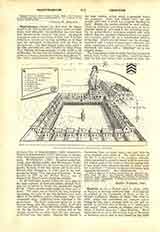

Charterhouse.—From the fact that St. Bruno founded the first house of his austere order at Chartreux, near Grenoble, the institution has ever since been known by the name of that place. By lingual corruption, just as each house of that order is known in Spain as cartuja and in Italy as certosa, so in England the corruption of Chartreux took the form of charterhouse. The first English house of the order—the first charterhouse—was founded by King Henry II at Witham in Somersetshire, in 1181 (with a cell on Mendip); the last was the celebrated charterhouse of Sheen in Surrey, founded in 1414 by King Henry V. The other charterhouses were those of Hethorpe, or Locus Dei, in Gloucestershire (1222), removed to Hinton in Somersetshire (1227); Beauvale, or Gresley Park, Nottinghamshire (1343); St. Anne’s near Coventry, Warwickshire (1381); Kingston-upon-Hull, Yorks, East Riding (1378); and Mountgrace, Yorks, North Riding (1396); but the most renowned of these houses, because of the fate meted out to its prior, Blessed John Houghton, in 1535, and to its community by Henry VIII, was that of London. It was founded in 1371 by Sir Walter Manny, one of Edward the Third’s most illustrious knights.
As all Carthusian houses follow the same plan in the main outlines of their disposition, though there may be variations in detail, one description stands for all. There are two court-yards, an outer and an inner. The outer one is flanked by long buildings containing the cells of the lay brethren, and such offices as the kitchen, pantry, bakehouse, forge, and carpenters’ shop. Adjoining these buildings is the guest-house. The inner courtyard gives on to the chapter house and the refectory, which is divided into two portions, one for the choir-monks, the other for the lay brethren. At the further end is the thumb, which has no aisles, and, like the refectory, is divided into two parts. Beyond the church is the large cloister, within which is generally found the cemetery. From this cloister open out the monks’ cells, each of which is a complete dwelling by itself. Besides the garden allotted to each recluse, which he cultivates according to his taste, he has a corridor where he may walk in the recreation hour. On the ground-floor a workroom stocked with tools affords him the necessary relaxation from his spiritual exercises, which fill up a considerable portion of the day. Above are two rooms: one, for sleeping, furnished with a board covered with a blanket; the other containing a stall and prie-Dieu, a work-table, bookshelf, two chairs, and a “refectory” set in the window recess.
The Carthusian’s habit is white; his food consists of bread, fruit, herbs, and vegetables, varied on feast days by fish and cheese; once a week, at least, the Carthusian fasts on bread, water, and salt; flesh he never touches, even when ill. The chief feature of the life in a charterhouse is its complete solitude, which has served to preserve intact in all its austerity the original spirit of the order; so that the saying that it has never been reformed because it never grew lax is justified—”Cartusia nunquam reformata, quia nunquam deformata.” See Carthusian Order.
HENRY NORBERT BIRT

